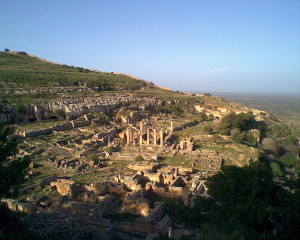 Excerpted from Christianity and Rabbinic Judaism- a Parallel History of their Origins and Early Development. Ed. Hershal Shanks. Washington D.C.- Biblical Archaeology Society, 1993.
Excerpted from Christianity and Rabbinic Judaism- a Parallel History of their Origins and Early Development. Ed. Hershal Shanks. Washington D.C.- Biblical Archaeology Society, 1993.
The Diaspora revolts
Under Trajan, a series of major revolts did in fact erupt, primarily affecting the Jews of the Diaspora. 74 In 115 C.E., Jews in Egypt and Cyrene (on the North African coast in present-day Libya) took advantage of Trajan’s absence ona Mesopotamian campaign to attack their Greek neighbors. The devastation in both Greek and Jewish communities was enormous; the Jews gained the upper hand in rural areas of Egypt, but were defeated in Alexandria. The hostilities were so severe that as late as the year 199/200 an annual festival was celebrated in the Egyptian town of Oxyrhynchus to commemorate the victory over the Jews. 75 To subdue the revolt in Cyrene, where the hostilities were even more devastating—some 220,000 people were massacred according to Dio 76 —Trajan sent one of his prized generals, Marcius Turbo. 77 The leader of these Jewish uprisings—called Lucuas by Eusebius and Andreas by Dio—appears to have had royal, if not messianic, aspirations; he claimed the title of king. 78 Archaeological evidence from Cyrene seems to bear out the enormity of this revolt- milestones found here refer to the “Jewish rebellion.” 79 A number of Roman temples in the city of Cyrene were found destroyed or damaged.
Cyprus was another area of violence involving Jews around 115 C.E. Some 240,000 pagans were said to have been killed; consequently Jews were banned from the island. 80 Finally, as Trajan advanced southward along the Tigris, the Jews of Mesopotamia rose in revolt. Trajan’s general, Lucius Quietus, was sent to quell this rebellion, which resulted in the death of thousands of Jews. 81
Whether these revolts among Diaspora Jewry affected Palestine is a much-debated question. Hadrian’s biographer notes that there was some kind of uprising in Judea at about this time. 82 Rabbinic tradition also records a war of Quietus, 83 who, after serving in Mesopotamia, became governor of Judea. Presumably this war of Quietus occurred in Judea.
Recent archaeological evidence seems to corroborate this picture of unrest in Judea for at least 15 years before the actual outbreak of the Bar-Kokhba revolt. The building of roads by the Roman army during the second and third decades of the second century undoubtedly had—as was usually the case—military implications. 81 Moreover, a number of legions, or parts thereof, appeared in Palestine during this period, probably in response to unrest among the local population—or in anticipation of it. These were the sparks that helped ignite the tinderbox.